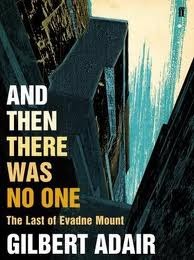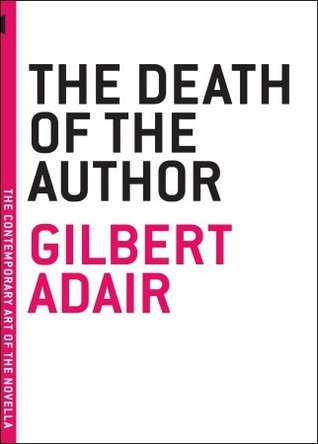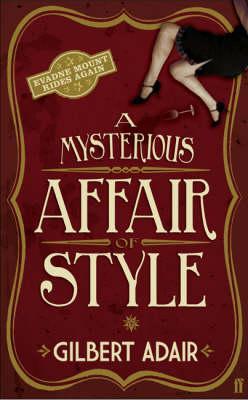Gilbert Adair, in the third of his Evadne Mount novels, changes tack and disposes with the cosy Christie model subverted successfully in The Act Of Roger Murgatroyd and less so in A Mysterious Affair Of Style, by opting to throw himself into the mix and tell the story of And Then There Was No One (2009) as a fictional memoir. Set in 2011, Adair has found himself at a literary festival in a Swiss town by the Reichenbach Falls, setting for Conan Doyle’s attempt at ridding himself of his popular detective character.
The influence of Sherlock Holmes plays as much a part in And Then There Was No One as that of Agatha Christie has for the triptych of Evadne Mount novels, and fans of Holmes may be interested to know that Adair reproduces, in full from his fictional new book of Sherlock Holmes stories, his take on The Giant Rat Of Sumatra, first mentioned in The Adventure Of The Sussex Vampire (cf The Casebook Of Sherlock Holmes) as “a story for which the world is not yet prepared”.
The reason for this change in the style of the novels comes late, but is worth mentioning, as Adair regularly talks about his novels, past, present, and in translation throughout:
For all my efforts to have the second novel ring as many changes on the first as was organically feasible within the generic conventions I was pastiching, there remained a stubbornly samey something about A Mysterious Affair of Style which long afterwards nagged at me. And not only at me. One reviewer, praising the book, had also expressed disappointment that I had taken an ‘if-it-ain’t-broke-don’t fix-it’ attitude to the first of the cycle, and I couldn’t help agreeing with him.
Like that novel, Adair begins by playing with the conventions of the murder mystery genre. Where the murder didn’t occur until late in A Mysterious Affair Of Style, the murder has long since been wrapped up here. The victim is Gustav Slavorigin, a Booker Prize-winning author sent, after publishing a collection of incendiary anti-American essays, into hiding, Rushdie style, due to a contract on his head, courtesy of a rich Texan reactionary.
The prologue, seemingly extraneous to the mystery itself, fills in details that, to a first read, seem dry and dull, and in doing so recalls both the introduction to Eco’s The Name Of The Rose and the short foreword to Nabokov’s Lolita. This in itself is strange, given that Adair has mentioned in the past that Nabokov has “become something of an albatross about [his] neck”. The details of this chapter deal with the history of Slavorigin – his early days at university, with Adair, through the rise, fall, and infamy of his writing career. One notable book, and the reason Slavorigin is making a rare public pitstop, is his new thriller, A Reliable Narrator, which gives the game away without, if you catch my drift, doing so.
How to describe A Reliable Narrator? Its opening chapter resembles the concluding chapter of a whodunnit, one that just happens never actually to have been written. Thus the reader of Slavorigin’s book (I mean, the book which was written) cannot hope to comprehend the picturesque twists of this first-chapter denouement since, of the murder which has clearly taken place, the only detail to which he is made privy is the identity of the murderer, a murderer who has already been apprehended, charged, tried, found guilty and sentenced to life imprisonment.
The idea of a reliable narrator is played around with too, as is Adair’s playful style. Personal views come into the fray, such as calling the forty-five minutes of literary festivals “so much hassle for so little result” and his description of a book as being “a fat, virtuosically executed novel by one of that new breed of American wunderkinder who, I would be lying if I denied it, are positively bloated with talent but who are also just too fucking pleased with themselves.” As a fictional Adair, he’s able to get away with it, even if, with reference to Slavorigin’s book:
The first-person protagonist is no canonic unreliable narrator, such a tired old cliché of postmodernism now, but a perfectly reliable narrator, except that not a single soul is prepared to rely on him.
The usual alliteration, literary and cinematic in-jokes, and postmodern trickery are present and accounted for in And Then There Was No One. The unashamed use of puns (‘Google Gogol’, a delicatessen named ‘Salvador Deli’ and a few more Nabokovian references, ‘Son of Palefire’ and ‘Adair or Ardor’) adds to the fun, and I’d like to think that only Adair’s style, like a British eccentric, could get away with a metaphor like “the train tranquilly unzipped the country’s flies from Oxford to London”.
One of the more interesting ploys in the novel is how, as a memoir, Adair manages to introduce his sleuth, the Dowager Duchess of Crime, Evadne Mount, into real events. As the last novel was set in the 1940s and this novel is seventy years hence, and she should be the one dropping dead, he pulls it off well, and humorously, too, introducing her into a book that she should never be written, as per a Q&A session after his reading of The Giant Rat Of Sumatra:
‘You wrote two pastiches of Agatha Christie, The Act of Roger Murgatroyd and A Mysterious Affair of Style? Will there be a third?’ Me: ‘Absolutely not. I have had my fill of cardboard characters and preposterous plotlines. What I desire to write now is something more personal, a work of genuine depth and ambition.
Amongst the answers at that session there are some interesting insights that, if we believe the reliable narrator, into Adair that show And Then There Was No One as being that personal work, bringing with it a few questions of its own:
‘I read a book, Alice in Wonderland, Peter Pan, Les Enfants terribles, Death in Venice, or whatever, I like it, I rewrite it. I am in short a pasticheur. Less by opportunism, though, than by superstition. I long ago discovered that I could embark on a new work of fiction only if its premise had already been legitimised by one of the writers in my personal Pantheon. Each of my novels is thus a palimpsest. Scrape away at its surface and you will find, underneath, another novel, usually a classic. I offer no apology for this.’
Apologies are not in order as Adair has produced his best novel since 1992’s The Death Of The Author. His funniest, too. It has more conceptual twists and turns than the labyrinth in Eco’s The Name Of The Rose, another novel that owes a debt to Sherlock Holmes, and probably why the Italian writer was also due to attend the same literary festival. In fact, in Eco’s essay, Travels In Hyperreality, he says that ‘once the “total fake” is admitted, in order to be enjoyed it must seem totally real’, and this is what Adair does with this novel, giving us a reliable narrator, so reliable that we can believe his every word, only to have the rug pulled out from under us, to see it for what it is, yet still believe.




Excellent review, Stewart. I also thought this to be an outstanding piece of work, certainly my favourite of Adair’s novels, which I adore for their erudite playfulness.
Thanks. If you haven’t read it yet, then Adair’s The Death Of The Author is arguably his best of the lot. I say that with one more — of the adult fictions — yet to read, and another to refresh myself with for this blog.